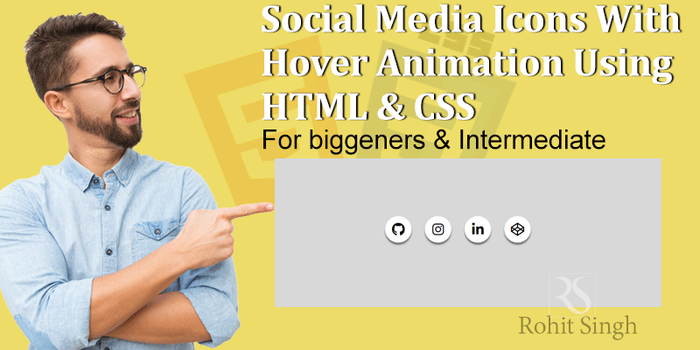HTML Basics: An Introduction to HTML

 Learn the fundamentals of HTML, the standard markup language for creating web pages. This article covers the history of HTML, its basic structure and syntax, and common elements such as headings, paragraphs, and links. Discover how HTML works with other technologies like CSS and JavaScript to create dynamic and interactive websites
Learn the fundamentals of HTML, the standard markup language for creating web pages. This article covers the history of HTML, its basic structure and syntax, and common elements such as headings, paragraphs, and links. Discover how HTML works with other technologies like CSS and JavaScript to create dynamic and interactive websitesHTML, or Hypertext Markup Language, is a programming language used to create and structure content on the World Wide Web. It allows developers to specify how text, images, and other content should be displayed on a web page and how users can interact with it.
HTML is an essential tool for anyone looking to build and maintain a website, as it provides the basic structure and layout for the content. Whether you are a beginner looking to create your first website or a seasoned developer looking to improve your skills, understanding the basics of HTML is essential.
In this article, we will provide an introduction to HTML and its purpose, as well as a brief history of its development. We will also give an overview of the structure and syntax of HTML and introduce some common HTML elements and their uses. Finally, we will discuss some advanced techniques and technologies that can be used in conjunction with HTML to create more dynamic and interactive websites.
History of HTML
HTML (Hypertext Markup Language) is a standardized system for displaying and formatting content on the web. It was first developed in the early 1990s, as a way to provide structure and formatting for text documents on the internet.
The first version of HTML, HTML 1.0, was released in 1993. It provided basic formatting options such as headings, paragraphs, and lists, as well as the ability to create hyperlinks between documents.
Since then, HTML has evolved significantly through various versions. HTML 2.0 was released in 1995, adding support for tables and the ability to embed images and other media. HTML 3.2, released in 1997, added support for more advanced formatting options and the ability to create interactive forms.
With the advent of the World Wide Web Consortium (W3C) in 1994, the development of HTML became more standardized and focused on accessibility and usability. The W3C released a series of updated versions of HTML, including HTML 4.0 in 1997 and HTML 4.01 in 1999.
In the early 2000s, a new version of HTML called XHTML was introduced, which combined HTML with XML (Extensible Markup Language) to create a more strict and modular version of the language.
In recent years, the latest version of HTML, HTML5, has become widely adopted. HTML5 introduced new features such as support for audio and video playback, the ability to draw graphics using the canvas element, and improved support for mobile devices.
HTML Structure and Syntax
HTML, or Hypertext Markup Language, is the standard markup language for creating web pages and web applications. It consists of a series of elements and tags that define the content and structure of a web page.
HTML Tags and Elements
HTML tags are used to mark up the beginning and end of an HTML element. They are written using angle brackets, and typically come in pairs, with an opening tag and a closing tag. For example, the following HTML code defines a paragraph element:
<p>This is a paragraph</p>HTML elements are the building blocks of an HTML document. They can contain content, and may also have attributes that provide additional information or instructions. For example, the a element (short for anchor) is used to create a hyperlink, and has an attribute called href that specifies the target URL:
<a href="https://www.example.com">Click here to visit example.com</a>Basic Structure of an HTML Document
An HTML document has a basic structure that consists of a head and a body. The head contains information about the document, such as the title and any CSS or JavaScript files that are needed. The body contains the actual content of the document, such as headings, paragraphs, and other elements.
Here is an example of the basic structure of an HTML document:
<!DOCTYPE html>
<html>
<head>
<title>My Web Page</title>
</head>
<body>
<h1>Welcome to my web page!</h1>
<p>Here is some content.</p>
</body>
</html>Common HTML Elements and Their Uses
HTML has a wide variety of elements that can be used to create and structure content on the web. Here are some of the most commonly used HTML elements:
Headings: Headings are used to indicate the importance of a piece of content, with h1 being the most important and h6 being the least. Headings are useful for organizing content into sections and for creating a hierarchy of information.
Paragraphs: Paragraphs are used to contain blocks of text. The p element is used to define a paragraph.
Links: The a element is used to create links to other web pages or to specific locations on the same page. Links are created using the href attribute, which specifies the destination of the link.
Images: The img element is used to insert images into an HTML document. The src attribute specifies the source of the image, and the alt attribute provides a text alternative for the image.
Lists: HTML has two types of lists: ordered lists and unordered lists. Ordered lists are created using the ol element, and each list item is marked with the li element. Unordered lists are created using the ul element in the same way.
These are just a few of the many HTML elements available. Other common elements include tables, forms, and buttons.
Advanced HTML techniques and technologies
HTML has evolved significantly since its inception in the early 1990s, and there are now many advanced techniques and technologies that are used to create modern websites. Some of the most important of these are HTML5, CSS, and JavaScript.
HTML5
HTML5 is the latest version of HTML, and it brings with it a number of new features and improvements. Some of the most notable features of HTML5 include:
- New structural tags for organizing content, such as header, footer, nav, and aside
- Improved support for audio and video content, without the need for third-party plugins
- Enhanced support for graphics, including the canvas element for drawing and the svg element for scalable vector graphics
CSS
Cascading Style Sheets (CSS) is a language that is used to style and layout HTML content. With CSS, you can control things like the font, color, and size of text, the spacing and layout of elements, and even the way a page is displayed on different devices.
JavaScript
JavaScript is a programming language that is often used in conjunction with HTML and CSS to add interactivity and dynamic behavior to websites. With JavaScript, you can create things like forms that validate user input, animations, and even games.
Together, these technologies form the foundation of modern web development, and they are essential tools for anyone looking to create interactive and engaging websites.
Congratulations on completing this introduction to HTML! You should now have a basic understanding of what HTML is, its history, and how it works.
HTML is a powerful tool for creating and structuring web content, and it is an essential part of the web development process. If you want to continue learning HTML and other web technologies, there are many resources available to help you on your journey.
Resources for Further Learning
- W3Schools : This website provides a comprehensive reference for HTML, as well as tutorials and exercises to help you practice your skills.
- MDN Web Docs: This website, maintained by Mozilla, offers in-depth documentation on HTML, as well as tutorials and guides for web development.
- Codecademy : This online platform offers interactive HTML courses and projects to help you learn HTML
- and other web technologies.
There are many other resources available, including online communities and forums where you can ask questions and connect with other web developers. With practice and dedication, you can become proficient in HTML and other web technologies.
Table of Contents

Related Posts






